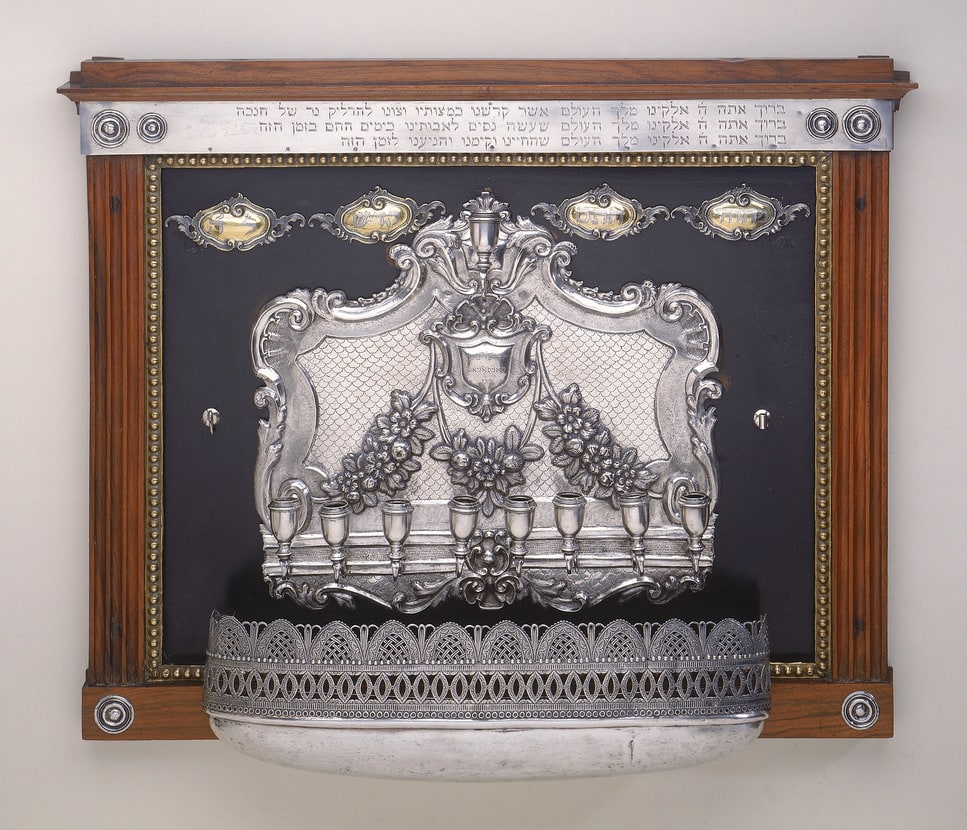
- Object Name:
- Hanukkah Lamp
- Artist/Maker:
- GB
- Place Made:
- Florence (?) (Italy)
- Date:
- 1781-1800; additions 1832-72
- Medium:
- Silver: repoussé, engraved, punched, and die-stamped; wood; copper alloy
- Dimensions:
- 23 1/4 × 28 × 4 3/4 in. (59.1 × 71.1 × 12.1 cm)
- Credit Line:
- The H. Ephraim and Mordecai Benguiat Family Collection
- Accession Number:
- S 262
Not On View
This lamp is composed of disparate elements, probably made at different times. The original part is the backplate and nine candleholders, which was later mounted in a wooden frame. The drip pan was probably added then, as were the four inscribed cartouches across the top. The practice of adding parts or reworking ceremonial objects was apparently quite common in Italy.
The backplate is stamped with the maker's initials, but no city mark. It is likely that it was made in Florence, since there is a Florence mark on the later drip pan. Made in rococo style, with its C-scrolls, rocaille elements, and flowers, the lamp itself could date from around 1750 to 1770. However, the absence of a city mark suggests that it was made after 1781, when it was decreed that objects with a silver content below required standards could not receive the mint mark. Such conservatism in decorative style is common in Italian Judaica, where the rococo style of the 1750s was continued several decades after its heyday.
The inscriptions include the words "Light to honor God" and "Holy to the Lord," which suggests that the lamp was dedicated to a synagogue. The donation was made by Yosef Campagnano, whose name is inscribed in the central shield. It is possible that this is the Giuseppe (Yosef in Hebrew) Vittorio Campagnano whose son gave a coral Torah pointer to the Italian Synagogue of Florence in 1847. This could be further evidence for the Florentine origin of the lamp.
The drip pan is marked with a stamp used by the city of Florence between 1832 and 1872. It is quite distinct in style from the backplate and was clearly made at a later date. Similarly, the four cartouches across the top, which are rococo in style, have completely different scrollwork from the lamp and were therefore not part of the original commission. All three elements were mounted to a wooden frame in nineteenth-century neoclassical style, at which time the upper plaque with the three blessings for kindling the lights was added.
The backplate is stamped with the maker's initials, but no city mark. It is likely that it was made in Florence, since there is a Florence mark on the later drip pan. Made in rococo style, with its C-scrolls, rocaille elements, and flowers, the lamp itself could date from around 1750 to 1770. However, the absence of a city mark suggests that it was made after 1781, when it was decreed that objects with a silver content below required standards could not receive the mint mark. Such conservatism in decorative style is common in Italian Judaica, where the rococo style of the 1750s was continued several decades after its heyday.
The inscriptions include the words "Light to honor God" and "Holy to the Lord," which suggests that the lamp was dedicated to a synagogue. The donation was made by Yosef Campagnano, whose name is inscribed in the central shield. It is possible that this is the Giuseppe (Yosef in Hebrew) Vittorio Campagnano whose son gave a coral Torah pointer to the Italian Synagogue of Florence in 1847. This could be further evidence for the Florentine origin of the lamp.
The drip pan is marked with a stamp used by the city of Florence between 1832 and 1872. It is quite distinct in style from the backplate and was clearly made at a later date. Similarly, the four cartouches across the top, which are rococo in style, have completely different scrollwork from the lamp and were therefore not part of the original commission. All three elements were mounted to a wooden frame in nineteenth-century neoclassical style, at which time the upper plaque with the three blessings for kindling the lights was added.
Information may change as a result of ongoing research.